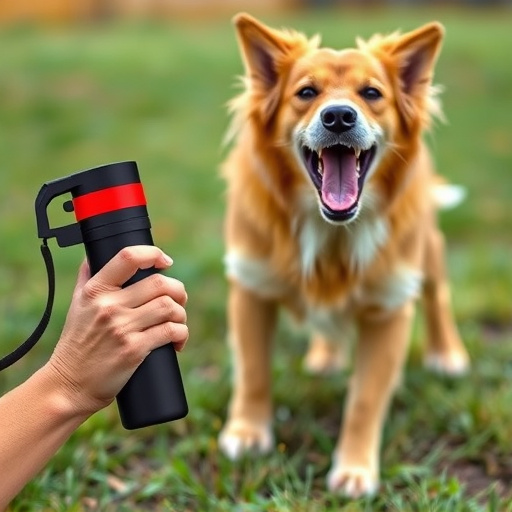Dog pepper spray, a non-lethal defense against aggressive dogs, is regulated in many US states due to animal welfare concerns. Known as Restricted States, these regions have stringent laws on canine-specific defense sprays, requiring proper training and legal compliance. Mail delivery workers, facing unique dog attack risks, benefit from specialized programs teaching threat identification and correct spray application. Exploring alternatives like flashlights, protective gear, and understanding dog behavior is crucial for mail deliverers in Dog Pepper Spray Restricted States to enhance safety and avoid legal issues.
“In today’s digital era, mail delivery workers face unique challenges, especially when navigating high-risk routes. One innovative solution gaining traction is dog defense spray, a powerful tool for self-protection against aggressive canine encounters. This comprehensive guide explores ‘Dog Pepper Spray Restricted States’, delving into its effectiveness and safety. We’ll cover understanding the spray, legal considerations in restricted areas, optimal use cases, training protocols, and alternative measures to ensure mail delivery workers’ safety.”
- Understanding Dog Pepper Spray: A Comprehensive Overview
- Legal Considerations: Dog Pepper Spray in Restricted States
- Effective Use Cases and Training for Mail Delivery Workers
- Safety Measures and Alternatives to Consider
Understanding Dog Pepper Spray: A Comprehensive Overview
Dog pepper spray, also known as canine pepper spray or dog defense spray, is a non-lethal self-defense tool designed to deter aggressive dogs. It’s a specialized type of pepper spray tailored for use by individuals who encounter potentially dangerous canines while delivering mail or performing other outdoor tasks. This spray contains capsaicin, the same compound found in hot peppers, which irritates the eyes, nose, and throat of the targeted dog, temporarily disabling it and allowing the user to escape unharmed.
While highly effective for deterring dogs, there are significant restrictions on where and how dog pepper spray can be used. In many US states, including California, New York, and Illinois, the use of pepper spray on dogs is strictly regulated or outright banned due to concerns about animal welfare and potential misuse. It’s crucial for users to understand the legal implications and safe handling procedures associated with dog pepper spray. Additionally, proper training and familiarity with the product are essential to ensure its effectiveness and minimize risks during encounters with aggressive canines.
Legal Considerations: Dog Pepper Spray in Restricted States
In many regions, the use of dog pepper spray is subject to strict regulations due to concerns about animal welfare and public safety. Dog pepper spray, or canine-specific defense sprays, are designed for non-lethal self-defense against aggressive dogs while allowing handlers to gain control and de-escalate potentially dangerous situations. However, their availability and legality vary significantly across Restricted States.
States with stringent animal protection laws often have restrictions on the types of force that can be used against animals, including pepper spray specifically designed for canines. These restrictions may vary from outright bans to specific guidelines governing the use, storage, and deployment of dog pepper spray. Individuals considering carrying such a device must thoroughly research local laws and obtain any necessary permits to ensure compliance with regulations, avoiding potential legal repercussions.
Effective Use Cases and Training for Mail Delivery Workers
Mail delivery workers often find themselves in diverse and potentially risky situations, making it crucial to equip them with effective self-defense tools. One innovative solution gaining traction is the use of dog defense spray. This specialized pepper spray is designed to deter aggressive dogs, providing a safe means for mail carriers to perform their duties without undue fear or danger.
Training plays a vital role in ensuring the successful implementation of this tool. Mail delivery workers must be taught how to properly identify and assess potential threats posed by dogs, as well as learn the correct application techniques for the dog defense spray. Many companies are now incorporating specialized training programs that simulate various scenarios, from encountering unfriendly pets to handling highly aggressive breeds. By mastering these skills, mail carriers can confidently navigate through residential areas, rural routes, and even urban centers where Dog Pepper Spray is Restricted in certain States, enhancing their safety and ensuring the secure delivery of mail across diverse landscapes.
Safety Measures and Alternatives to Consider
Mail delivery workers often face unique challenges, and ensuring their safety is paramount. While dog defense spray can be a deterrent, it’s crucial to understand its restrictions and alternatives. Dog pepper spray, also known as canine repellent, contains capsaicin, similar to that found in chili peppers, which can temporarily incapacitate a dog. However, its use comes with considerations; not all states allow the open carrying of pepper spray, and specific regulations exist for its application, especially around animals.
Exploring alternative safety measures is essential, such as carrying non-lethal tools like flashlights or whistles to startle dogs, wearing protective gear, and learning dog behavior cues to avoid attacks. Additionally, maintaining a safe delivery route by staying in well-lit areas and avoiding known high-risk zones can significantly reduce potential hazards. Remember, knowledge of local laws regarding dog pepper spray is vital to ensure compliance and contribute to a safer working environment for mail deliverers.
Mail delivery workers facing aggressive dog encounters can benefit from understanding Dog Pepper Spray, a powerful tool in restricted states where traditional methods may be limited. While legal considerations vary across regions, proper training and safety measures ensure its effective use. By exploring real-world use cases and considering alternatives, professionals can enhance their protection while navigating challenging canine situations, ultimately ensuring safer mail delivery.
